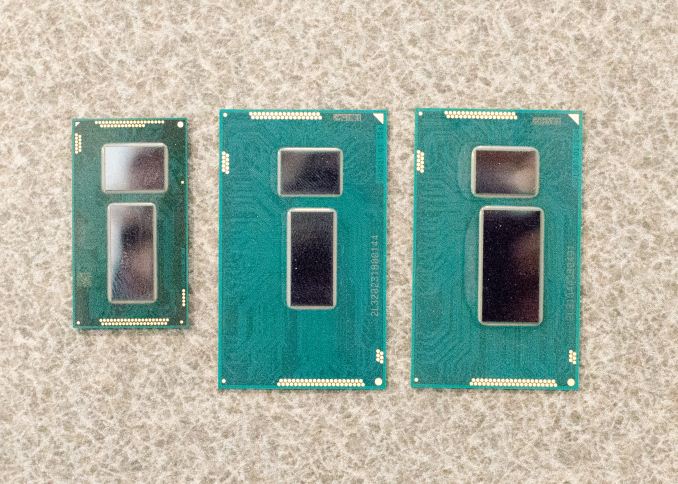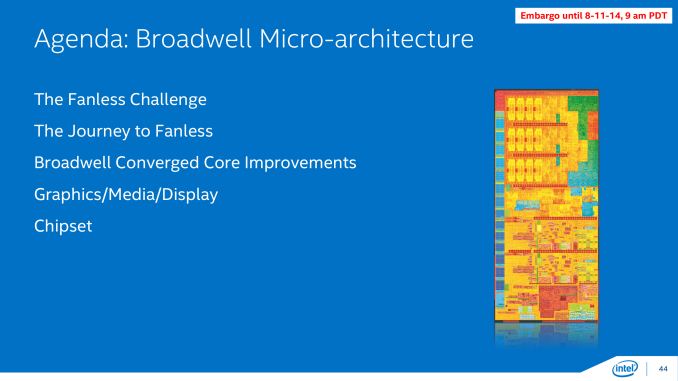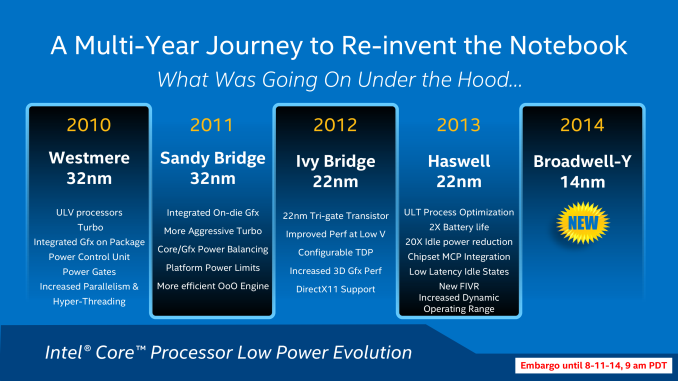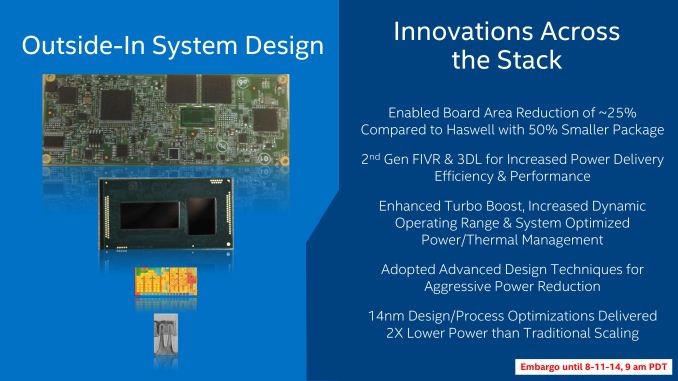Intel Broadwell Architecture Preview: A Glimpse into Core M
by Ryan Smith on August 11, 2014 12:01 PM EST
With Haswell Refresh fully behind us and 2014 now in to its second half, Intel is turning their attention to their next generation of products and processes. Intel’s tick-tock methodology coupled with the long development periods of new products means that the company has several projects in flight at any given time. So while we have seen the name Broadwell on Intel’s roadmaps for some time now, the reality of the situation is that we know relatively little about Intel’s next generation architecture and the 14nm process that it is the launch vehicle for.
Typically we would see Intel unveil the bulk of the technical details of their forthcoming products at their annual Intel Developer Forum, and with the next IDF scheduled for the week of September 9th we’ll see just that. However today Intel will be breaking from their established standards a bit by not waiting until IDF to deliver everything at once. In a presentation coinciding with today’s embargo, dubbed Advancing Moore’s Law in 2014, Intel will be offering a preview of sorts for Broadwell while detailing their 14nm process.
Today’s preview and Intel’s associated presentation are going to be based around the forthcoming Intel Core M microprocessor, using the Broadwell configuration otherwise known at Broadwell-Y. The reason for this is a culmination of several factors, and in all honesty it’s probably driven as much by investor relations as it is consumer/enthusiast relations, as Intel would like to convince consumer and investor alike that they are on the right path to take control of the mobile/tablet market through superior products, superior technology, and superior manufacturing. Hence today’s preview will be focused on the part and the market Intel feels is the most competitive and most at risk for the next cycle: the mobile market that Core M will be competing in.
To that end Intel’s preview is very much a preview; we will see bits and pieces of Broadwell’s CPU architecture, GPU architecture, and packaging, along with information about Intel’s 14nm process. However this isn’t a full architecture preview or a full process breakdown. Both of those will have to wait for Intel’s usual forum of IDF.
Diving into matters then, Core M will be launch vehicle for Broadwell and will be released for the holiday period this year. In fact Intel is already in volume production of the Broadwell-Y CPU and production units are shipping to Intel’s customers (the OEMs) to begin production and stockpiling of finished devices for the holiday launch.
Intel’s decision to initially focus Broadwell on the mobile market comes as the company takes the next step in their plan to extend into the Core processor series into these devices. Arguably, Intel has been slow to response to the rise of ARM devices, whose rapid rise has undercut traditional PC sales and quickly become the biggest threat to Intel’s processor dominance in some number of years. Intel is far from doomed right now, but even they see the potential farther down the line if they do not act.
Intel for their part has responded, but it has taken a step-by-step (multi-year) process that has seen the company progressively build smaller and less power hungry CPUs in order to fit the needs of the mobile market. Since Intel integrated their graphics on-die with Sandy Bridge in 2011, the company has continued to tweak the designs of their products, with Ivy Bridge and Haswell generation products introducing further optimizations and new manufacturing processes. Now on their latest iteration with Broadwell, the company believes they’re turning a corner and have the technology they need to be a leader in the high performance mobile market. It's important to note that despite Intel's best intentions here, Broadwell and Core M remain targeted at premium devices. You won't see these parts in cheap tablets. The duty of doing battle with ARM remains Atom's alone.
Many of these changes ultimately amount to boosting performance and reducing power consumption to a point where power and heat are where they need to be for mobile form factors, either through process efficiency improvements or through better power management and wider dynamic ranges – boosting where it matters and doing a better job of idling between tasks. However as Intel has discovered they not only need to be able to meet the TDP requirements of a tablet but they need to be able to meet the size requirements too. A particularly daunting task when the entire thickness of a device needs to be under 10mm, and the CPU thinner yet.
As a result, coupled with Core M’s performance improvements and power reductions is a strong emphasis on the size of the processor package itself and what Intel could do to reduce it. Intel calls this an outside-in system design, with various parts of Intel focusing on everything from the size of the logic board needed to hold the processor to the thickness of the processor die itself. In the following pages we’ll take a look at Intel’s efforts to get slim, but to kick things off we have a picture of Broadwell-Y from Computex 2014.

From left to right: Broadwell-Y (Core M), Broadwell ULT/ULX and Haswell ULT/ULX
Intel wants a greater foothold in the mobile market and they want it badly. And with Broadwell-Y they believe they finally have what they need to accomplish that goal.














158 Comments
View All Comments
Krysto - Monday, August 11, 2014 - link
M stands for Mediocre. The main reason they are hitting those TDP levels is because they are reducing performance for those specific chips that they claim to use little power.I also bet Broadwell will jump even higher in price than Haswell, which also jumped 40 percent over IVB, considering they're having significant yield issues.
Grizzlebee - Monday, August 11, 2014 - link
I'm looking at prices right now on Newegg and there is a 5-10$ difference between Ivy Bridge and Sandy Bridge in price. Not even close to 40%.Krysto - Monday, August 11, 2014 - link
Original prices. Haswell is not the "mass market" chip for Intel, which means high volume, and can afford lower prices than initially, while IVB is low volume chip now, so it won't be much cheaper. Watch for when Broadwell comes out. It won't be just 10 percent more expensive than Haswell.bebimbap - Monday, August 11, 2014 - link
I believe Krysto was referring to the jump in prices from IB to HW, and not SB to IB.But either case, I'll have to disagree with Kyrsto. prices seems to have decreased over the years if anything. don't forget, because of IPC gains you are paying the same for more performance.
3570 = $210
4590 = $200
2320 = $190
3330 = $190
4430 = $180 w/ $10 off promo applied.
Gondalf - Monday, August 11, 2014 - link
All depends on from factor. If you want a tiny tablet, this is the only manner to do it.Or you do like Tegra K1 that scores 12W under full GPU operations??? Come on, put it in a slim convertible if you can.
HardwareDufus - Monday, August 11, 2014 - link
Pretty sure M stands for Mobile.Will be interesting to see what this means for Desktop variants. Want to see what improvements come the way of the GT3+ gpu.
gostan - Monday, August 11, 2014 - link
"and as we’ve seen with ARM based tablets so far they form a market that has continued to grow and continued to erode the x86 laptop market that Intel has dominated for so long."Is this your assumption or is it a fact? If the latter is true, can you provide some references?
Ryan Smith - Monday, August 11, 2014 - link
"If the latter is true, can you provide some references?"Sure.
http://www.gartner.com/newsroom/id/2647517
http://www.gartner.com/newsroom/id/2420816
Gartner regularly tracks PC unit sales, and tablets are regularly cited as a factor. On a more micro level, I know several people who have reduced their PC usage over the last couple of years (and delaed PC replacements) due to their tablet use.
Flunk - Monday, August 11, 2014 - link
http://www.forbes.com/sites/haydnshaughnessy/2014/...Tablet sales are falling too. Perhaps there is no relation at all and just an overall tightening due to the market maturing.
HanzNFranzen - Monday, August 11, 2014 - link
that doesn't seem to be the case.http://techcrunch.com/2014/07/06/gartner-device-sh...